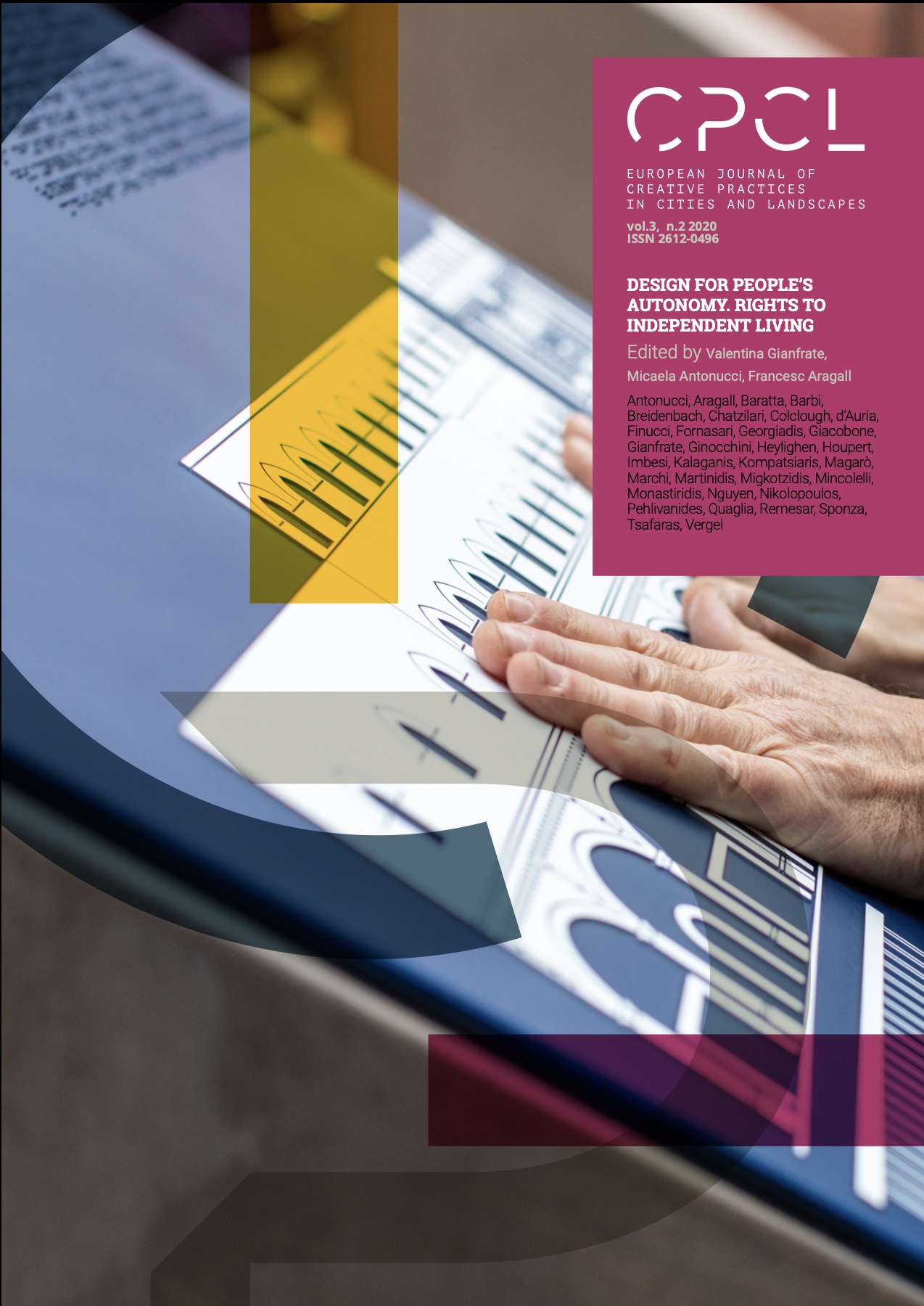Understanding independent living with autism: The role of the housing environment in the experiences of two autistic men
DOI:
https://doi.org/10.6092/issn.2612-0496/10781Keywords:
autism, housing environment, independent living, lived experienceAbstract
Many autistic adults continue living with their parents rather than living independently, regardless of their IQ levels. In studies about adaptive housing, their perspective is still lacking. To address this gap, our research aims to offer insight into, first, autistic adults’ experiences of living independently, and second, what role the housing environment plays in these experiences. A qualitative study was set up to investigate what living independently means to two autistic men. The findings suggest that living independently for them means (1) living in proximity of public facilities, retail stores and family, (2) self-determining their apartment arrangement, daily living activities, and (3) having nearby social contacts to cope with regular domestic stress and anxiety. Comparing their experiences suggests that social and physical factors of the housing environment are not detached, but could strengthen each other in supporting their independent living. The combination of social and physical factors facilitates living independently for these men, which resonates with the paradigm of independent living. A better understanding of autistic people’s lived experiences is crucial to develop housing options which enable them to live independently.
References
Ahrentzen, Sherry, and Kimberly Steele. “Advancing Full Spectrum Housing.” ASU Stardust Center (blog), 2009. https://sustainability.asu.edu/stardust/project-archive/advancing-full-spectrum-housing/.
Anderson, Kristy A., Paul T. Shattuck, Benjamin P. Cooper, Anne M. Roux, and Mary Wagner. “Prevalence and Correlates of Postsecondary Residential Status among Young Adults with an Autism Spectrum Disorder:” Autism, August 30, 2013. https://doi.org/10.1177/1362361313481860.
Billstedt, Eva, I. Carina Gillberg, and Christopher Gillberg. “Aspects of Quality of Life in Adults Diagnosed with Autism in Childhood: A Population-Based Study.” Autism 15, no. 1 (January 2011): 7–20. https://doi.org/10.1177/1362361309346066.
Bölte, Sven. “Hey Autism Researcher, What’s on Your Mind Today about Inclusion?” Autism 23, no. 7 (October 1, 2019): 1611–13. https://doi.org/10.1177/1362361319870994.
Dejong, Gerben. “Independent Living: From Social Movement to Analytic Paradigm” 60 (1979): 12.
Dierckx de Casterlé, Bernadette, Chris Gastmans, Els Bryon, and Yvonne Denier. “QUAGOL: A Guide for Qualitative Data Analysis.” International Journal of Nursing Studies 49, no. 3 (March 2012): 360–71. https://doi.org/10.1016/j.ijnurstu.2011.09.012.
Dillenburger, Karola, and Lynne McKerr. “Echoes of the Future: Adults with Disabilities Living at Home with Their Parents” 1, no. 2 (2014): 10.
Howlin, Patricia, Susan Goode, Jane Hutton, and Michael Rutter. “Adult Outcome for Children with Autism.” Journal of Child Psychology and Psychiatry 45, no. 2 (2004): 212–29. https://doi.org/10.1111/j.1469-7610.2004.00215.x.
Howlin, Patricia, and Iliana Magiati. “Autism Spectrum Disorder: Outcomes in Adulthood.” Current Opinion in Psychiatry 30, no. 2 (March 2017): 69–76. https://doi.org/10.1097/YCO.0000000000000308.
Howlin, Patricia, and Philippa Moss. “Adults With Autism Spectrum Disorders.” Canadian Journal of Psychiatry 57, no. 5 (May 2012): 275–83.
Howlin, Patricia, Sarah Savage, Philippa Moss, Althea Tempier, and Michael Rutter. “Cognitive and Language Skills in Adults with Autism: A 40-Year Follow-Up.” Journal of Child Psychology and Psychiatry 55, no. 1 (January 2014): 49–58. https://doi.org/10.1111/jcpp.12115.
Howlin, Patricia, and Pamela Yates. “The Potential Effectiveness of Social Skills Groups for Adults with Autism:” Autism, June 29, 2016. https://doi.org/10.1177/1362361399003003007.
Kenny, Lorcan, Caroline Hattersley, Bonnie Molins, Carole Buckley, Carol Povey, and Elizabeth Pellicano. “Which Terms Should Be Used to Describe Autism? Perspectives from the UK Autism Community.” Autism 20, no. 4 (May 2016): 442–62. https://doi.org/10.1177/1362361315588200.
Kim, So Yoon. “The Experiences of Adults with Autism Spectrum Disorder: Self-Determination and Quality of Life.” Research in Autism Spectrum Disorders 60 (April 1, 2019): 1–15. https://doi.org/10.1016/j.rasd.2018.12.002.
Kim, So Yoon, and Kristen Bottema-Beutel. “A Meta Regression Analysis of Quality of Life Correlates in Adults with ASD.” Research in Autism Spectrum Disorders, Growing older with autism, 63 (July 1, 2019): 23–33. https://doi.org/10.1016/j.rasd.2018.11.004.
Kinnaer, Marijke, Stijn Baumers, and Ann Heylighen. “Autism-Friendly Architecture from the Outside in and the inside out: An Explorative Study Based on Autobiographies of Autistic People.” Journal of Housing and the Built Environment 31, no. 2 (June 2016): 179–95. https://doi.org/10.1007/s10901-015-9451-8.
Krauss, M. W., M. M. Seltzer, and H. T. Jacobson. “Adults with Autism Living at Home or in Non-Family Settings: Positive and Negative Aspects of Residential Status.” Journal of Intellectual Disability Research 49, no. 2 (February 2005): 111–24. https://doi.org/10.1111/j.1365-2788.2004.00599.x.
Major, Claire Howell, and Maggi Savin-Baden. Qualitative Research: The Essential Guide to Theory and Practice. London: Routledge, 2013.
Osterwitz, Ingolf. “The Concept of Independent Living - a New Perspective in Rehabilitation,” 1994.
Renty, J O, and Herbert Roeyers. “Quality of Life in High-Functioning Adults with Autism Spectrum Disorder: The Predictive Value of Disability and Support Characteristics.” Autism 10, no. 5 (September 1, 2006): 511–24. https://doi.org/10.1177/1362361306066604.
Sinclair, Jim. “Being Autistic Together.” Disability Studies Quarterly 30, no. 1 (February 22, 2010). https://doi.org/10.18061/dsq.v30i1.1075.
Steele, Kim, and Sherry Ahrentzen. At Home with Autism: Designing Housing for the Spectrum. Policy Press, 2015.
Tantam, Digby. “Psychological Disorder in Adolescents and Adults with Asperger Syndrome:” Autism, June 30, 2016. https://doi.org/10.1177/1362361300004001004.
Teti, Michelle, Nancy Cheak-Zamora, Bridget Lolli, and Anna Maurer-Batjer. “Reframing Autism: Young Adults With Autism Share Their Strengths Through Photo-Stories.” Journal of Pediatric Nursing 31, no. 6 (November 2016): 619–29. https://doi.org/10.1016/j.pedn.2016.07.002.
Venter, A., C. Lord, and E. Schopler. “A Follow-up Study of High-Functioning Autistic Children.” Journal of Child Psychology and Psychiatry, and Allied Disciplines 33, no. 3 (March 1992): 489–507. https://doi.org/10.1111/j.1469-7610.1992.tb00887.x.
World Health Organization. “Autism Spectrum Disorders.” Fact sheets, April 2, 2018. https://www.who.int/news-room/fact-sheets/detail/autism-spectrum-disorders.
Downloads
Published
How to Cite
Issue
Section
License
Copyright (c) 2020 Phuong Nguyen, Viviana d’Auria, Ann Heylighen

This work is licensed under a Creative Commons Attribution 4.0 International License.




